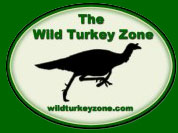|
Beard
Characteristics -- How to Age Your Gobbler
-- by Rob Ramsdale
--
Beards are another variable
that may be used in determining the age of a gobbler.
Generally, beards grow at a rate of 4" to 5"
a year and never stop growing. They also will usually
get wider and thicker as the gobbler ages. Knowing
this, you can be fairly certain a gobbler with a beard
of less than 5" is a one year old bird.There
are still exceptions to this though since mature gobblers
can lose most or all of the beard to various causes.
The beard length is only
partially helpful in determining the age of a gobbler
because after a bird reaches the age of 2 when the
beard reaches a length of 9" to 10" and
it starts to wear down at the tip. When the bird feeds,
the beards tip is worn by both getting stepped on
by the tom and by dragging on the ground.
There are also many other
variable which can affect the length of a beard including:
- Growth Rate -- Some birds
simply grow beards fast enough to overcome the wear
factor.
- Habitat -- Some geographical
areas have ground which is "softer" and
does not wear the beard tips as much. Swampy area
birds (Osceola) generally have longer beards and
spurs than rocky area birds (Merriam's).
- Leg Length -- If the legs
are longer (like on an Osceola) the beard will grow
longer before it starts to wear at the end.
- Filament Strength -- Beards
with stronger individual filaments will not wear
as quickly.
- Thickness: -- If a beard
is really thick with lots of filaments and a large
circumference, it will not wear as fast as a thin,
wispy beard.
- Diet -- Certain foods may
make a beard tougher and more wear resistant.
- Climate -- Northern birds
or birds in areas with high snowfalls will often
lose the tips of their beards when ice builds up
on them and they break off.
- Disease -- Turkeys will
occasionally get a melanin deficiency in their beard.
Melanin is the pigment that makes the beard black
and sometimes the melanin production is stopped
during the growth of the beard and the beard gets
a blonde or light colored streak across it. Usually
the melanin production will pick back up and the
rest of the beard will be black but the beard will
always have that blonde streak through it. The light-colored
portion of the beard is much more brittle and weaker
than the black portions and the beards will often
break off at that point or stop growing. Some turkeys
suffering from this will have completely blonde
beards.
The best research I have seen relating
beard characteristics to the age of a wild turkey
gobbler can be found in Lovett Williams books "The
Book of the Wild Turkey" (1981)
and "After
the Hunt " (1996).
In these books he talks about examining
the tips of the beards to aid in determining the age
of a gobbler. The end of a young gobbler's beard will
appear translucent amber when held up to a light and
it will have smooth, rounded tips on the filaments.
As the beard continues growing, the amber tip will
eventually wear off and the ends of the filaments
will become jagged. Thus a gobbler with a 10"
beard that still has its amber tips would be a 2 year
old gobbler since the beard hasn't grown enough yet
to completely wear off the amber tips.
|
Beard
Length
|
Tip
Color |
Age
|
|
0" to 4"
|
Amber |
Younger than 1 year
|
|
4" to 5"
|
Amber |
1 year
|
|
8" to 10"
|
Amber |
2 years
|
|
10" plus
|
Black |
3 years or older
|
Source: "The Book of the
Wild Turkey - Williams" (1981)
Next
Page >>
|

